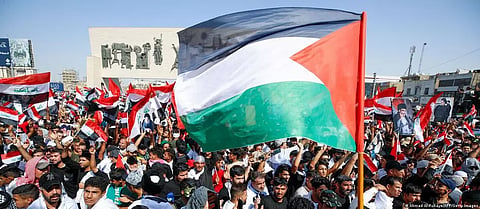

WASHINGTON: The message seemed to be clear. The rockets and drones fired at US bases in Iraq and Syria over the past week meant that members of Iraq’s militias and Yemen’s Houthi rebels were not pleased with the US’ apparently unconditional support for Israel. Since terror attacks on Israel by the militant Islamist Hamas on October 7, the Israeli military has been bombing the densely populated Gaza Strip, as well as preventing most food, water, fuel and medical supplies from entering the area. A blockade enforced by Israel since 2007 has restricted imports to the region and prevented most people from leaving.
The Israeli government has said more than 1,400 Israelis died in the Hamas attacks. In Gaza, more than 5,000 have since been killed by retaliatory Israeli bombing, according to the Hamas-run health authorities. The exact numbers cannot be independently verified, but the Gaza death toll continues to climb as the Israeli bombing and blockade continues. As a result, the mood among members of armed groups in Iraq and Yemen that consider themselves Hamas allies is tense.
“Fuller Israeli intervention in Gaza risks an escalation by Hamas’ allies in the so-called Axis of Resistance, an Iran-led regional alliance that also includes Lebanon’s Hezbollah, various Iraqi paramilitary factions and the Houthi movement in Yemen,” analysts at the US-based think tank The Century Foundation wrote in a commentary on October 16. Hamas, which launched the brutal attacks on Israel, rules Gaza and is classified as a terrorist organization by the European Union and countries including the US, Germany and the United Kingdom. Hezbollah is a larger militia group and also a political party based in Lebanon. Hezbollah’s armed wing is classified as a terrorist organization by some countries.
In Iraq, the militias in question were created after 2014 when locals volunteered to fight the extremist “Islamic State” group in that country. This is why they are broadly known as the Popular Mobilization Forces, or PMF. The militias’ ideologies vary and some now have political wings sitting in the Iraqi parliament. Others are more militant. Many are supported financially and tactically by Iran.
The Houthi rebel movement has been fighting a civil war with Yemen’s official government since 2014, in part as a reaction to rising Saudi influence. The Houthis are also supported by Iran. Senior members from two of Iraq’s largest militia groups have expressed their opposition to what is happening in Gaza.
“If America enters this battle directly, we will consider all Americans legitimate targets,” said Hadi Al-Amiri, leader of the Badr Organization, in a press statement two days after the Hamas attack.
“The Americans are essential partners in killing the people of Gaza and therefore they must bear the consequences,” Jaafar al Hussein, spokesman of the Kataib Hezbollah, announced on the messaging platform Telegram on October 18.
Before the current conflict flared up, there had been some pause in hostilities between the US and the Iraqi militias, who have often said they want the US out of Iraq and who have previously fired rockets at US bases.
Since the October 17 bombing of a Gaza hospital, such attacks have started again. Militias have claimed responsibility for around 11 drone or rocket attacks on US bases in Iraq and Syria. One US serviceperson died as the result of a heart attack suffered during one of the attacks, and others were slightly injured but were able to return to duty afterwards.